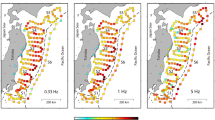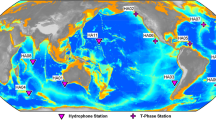Summary
An electronic sound spectrograph has been used to analyze the transients in complicated earthquake and explosion signals. Transient analysis with a sound spectrograph gives a means for directly obtaining group velocity at each of the spectral frequencies for each of the separate arrival branches, for any type of transient signal. Compared to frequency analysis, it presents the fine spectral structure of the signal as it changes with time, not an average over a time that includes many parts of the seismic signal.
Dispersion as well as the body wave spectrum of theP wave has been observed by transient analysis of seismic signals. Dispersion has also possibly been observed in theS wave, and in the various multiply reflectedS waves, which have been found to increase in period from one arrival to the next. The dispersed pattern of arrival of fundamental and higher mode surface waves has been observed for oceanic, continental, and mixed paths. Among these signals is a clear indication of the continental second shear mode. The separation of surface waves for the direct and complementary paths has also been accomplished. Our results compare well with those obtained by standard techniques.
The dispersion of the fundamental and higher mode signals from explosive sources in shallow water may be easily studied by making sound spectrograms and amplitude sections of these seismic signals. These shallow water shots show bubble pulses and Airy phases, which are clearly defined on the spectrograms and sections.
Zusammenfassung
Ein elektronischer Schallspektrograph wurde benutzt, um die nichtstationären Vorgänge in komplizierten Erdbeben- und Explosionswellen zu analysieren. Die Analyse von nichtstationären Vorgängen mittels dieses Schallspektrographen ergibt unmittelbar die Gruppengeschwindigkeit jeder einzelnen Spektralfrequenz für die verschiedenen seismischen Wellenphasen, die ja solche nichtstationären Vorgänge darstellen. Verglichen mit einer gewöhnlichen Frequenzanalyse liefert diese Art von Analyse die Spektralfeinstruktur des zeitlich sich ändernden Signals und nicht ein Mittel über ein Zeitintervall, das einen grösseren Teil des seismischen Schwingungsablaufs umfasst.
Sowohl Dispersionserscheinungen in derP-Welle als auch deren diskretes Amplitudenspektrum wurden mit Hilfe dieser Analyse seismischer Signale festgestellt. Dispersion wurde mit ziemlicher Wahrscheinlichkeit auch bei derS-Welle beobachtet, und in den verschiedenen mehrfachreflektiertenS-Wellen zeigt sich in aufeinanderfolgenden Reflexionen eine Periodenzunahme. Das disperse Erscheinungsbild der Oberflächenwellen in ihrer Grundschwingungstype und den zugehörigen Schwingungstypen höherer Ordnung wurde für ozeanischen, kontinentalen und gemischten Weg aufgenommen. Unter diesen Wellentypen findet sich eine klare Andeutung der kontinentalen Scherschwingungsform zweiter Ordnung vom Rayleigh-Typus (Second Shear Mode). Die Aufspaltung von Oberflächenwellen für direkten und antipodalen Weg wurde ebenfalls erreicht. Unsere Ergebnisse zeigen eine gute Übereinstimmung mit den von herkömmlichen Methoden stammenden Resultaten.
Die Dispersion von Wellentypen erster und höherer Ordnung, die durch Explosionen im Seichtwasser angeregt werden, kann leicht an Hand der Schallspektrogramme und momentanen Amplitudenspektren ihrer seismischen Signale untersucht werden. Solche Seichtwasserdetonationen zeigen Pulsationen und Airy-Phasen, die sich eindeutig auf den Spektrogrammen und Amplitudenbildern abzeichnen.
Similar content being viewed by others
References
Benioff H.:Earthquake seismographs and associated instruments. Advances in Geophysics, Academic Press, New York, Vol. 2, pp. 219–275 (1955).
Benioff H. &Gutenberg B.:Progress report, Seismological Laboratory, California Institute of Technology, for 1951. Trans. Amer. Geophys. Union, Vol. 33, pp. 759–762 (1952).
Bereza G. V., Slutskovskiy A. I. &Polshkov M. K.:Frequency analysis of seismic vibrations (in Russian). Prikladnaya Geofiz., Vol. 11, pp. 92–123 (1954).
Caloi P.:Sur l'origine des ondes de type superficiel, associées aux ondes S, SS, SSS, Publ. Bur. Centr. Séismol. Internat., Série A, Travaux Sci., Fasc. 17, pp. 235–241 (1950).
Caloi P.:C i,j , Annali di Geofisica, Vol. 8, pp. 293–313 (1955).
Carder D. S.:Seismic surface waves and the crustal structure of the Pacific region. Bull. Seism. Soc. Amer., Vol. 24, pp. 231–302 (1934).
Coulomb J.:Love waves of the Queen Charlotte Islands earthquake of August 22, 1949. Bull. Seism. Soc. Amer., Vol. 42, pp. 29–36 (1952).
Drake C. L.:Dispersion of explosive sound on Georges Bank. Earthquake Notes, Vol. 26, pp. 48–49 (1955).
Duffus H. J., Nasmyth P. W., Shand J. A. &Wright, C.:Sub-audible geomagnetic fluctuations. Nature, Vol. 181, pp. 1258–1259 (1958).
Eckart C.:The approximate solution of one-dimensional wave equations. Rev. Mod. Phys., Vol. 20, pp. 399–417 (1948).
Gutenberg B. &Richter C. F.:On seismic waves (First Paper). Gerlands Beiträge zur Geophysik, Vol. 43, pp. 56–133 (1935); (Second Paper). Gerlands Beiträge zur Geophysik, Vol. 45, pp. 280–360 (1935).
Gutenberg B.:Spectrum of P and S in records of distant earthquakes. Ztschr. Geophysik, Vol. 23, pp.316–319 (1957).
Hersey J. B.:Acoustic instrumentation as a tool in oceanography. In: Oceanographic Instrumentation. Nat. Res. Council Publ. No. 309, pp. 101–122 (1954) [Woods Hole Contribution No. 697].
Jakosky J. J. &Jakosky J. J. Jr.:Frequency analysis of seismic waves. Geophysics, Vol. 17, pp. 721–738 (1952).
Kasahara K.:The nature of seismic origins as inferred from seismological and geodetic observations (1). Bull. Earthqu. Res. Inst., Tokyo, Vol. 35, pp. 473–532 (1957).
Kersta L. G.:Amplitude crosssection representation with the sound spectrograph. Journ. Acoust. Soc. Amer., Vol. 20, pp. 796–801 (1948).
Koenig W., Dunn H. K. &Lacy, L. Y.:The sound spectrograph. Journ. Acoust. Soc. Amer., Vol. 18, pp. 19–49 (1946).
Koenig W. &Ruppel, A. E.:Quantitative amplitude representation in sound spectrograms. Journ. Acoust. Soc. Amer., Vol. 20, pp. 787–795 (1948).
Landisman M., Satô Y. &Ewing M.:The distortion of pulse-like earthquake signals by seismographs. Geophys. Journ., Vol. 2, pp. 101–115 (1959).
Neumann F.:The velocity of seismic surface waves over Pacific paths. Bull. Seism. Soc. Amer., Vol. 19, pp. 63–76 (1929).
Oliver J., Dorman J. & Ewing M.:Surface wave dispersion for oceanic paths. (Oral presentation at the Meeting of the Seismological Society of America inTucson, Arizona, April 1959).
Oliver J. &Ewing M.:Normal modes of continental surface waves. Bull. Seism. Soc. Amer., Vol. 48, pp. 33–49 (1958).
Oliver J. E., Ewing M. &Press F.:Crustal structure and surface-wave dispersion. Part IV: Atlantic and Pacific Ocean Basins. Bull. Geol. Soc. Amer., Vol. 66, pp. 913–946 (1955).
Pekeris C. L.:Theory of propagation of explosive sound in shallow water (pp. 1–117),and Worzel J. L. & Ewing M.:Explosion sounds in shallow water (pp. 1–53), in: Geol. Soc. Amer., Memoir 27 (1948).
Peterson G. E.:Design of visible speech devices. Journ. Acoust. Soc. Amer., Vol. 26, pp. 406–413 (1954).
Peterson G. E. &Raisbeck G.:The measurement of noise with the sound spectrograph. Journ. Acoust. Soc. Amer., Vol. 25, pp. 1157–1162 (1953).
Potter R. K.: U. S. Patent No. 2,403, 997 (1946).
Potter R. K., Kopp G. A. &Green H. C.:Visible speech. Van Nostrand, New York, 441 p. (1947).
Press F., Ewing M. &Tolstoy I.:The Airy phase of shallow-focus submarine earthquakes. Bull. Seism. Soc. Amer., Vol. 40, pp. 111–148 (1950).
Satô Y.:Attenuation, dispersion, and the wave guide of the G wave. Bull. Seism. Soc. Amer., Vol. 48, pp. 231–251 (1958).
Satô Y.:Numerical integration of the equation of motion for surface waves in a medium with arbitrary variation of material constants. Bull. Seism. Soc. Amer., Vol. 49, pp. 57–77 (1959).
Shamina O. G.:Frequency analysis of seismic oscillations (in Russian) Akad. Nauk. SSSR Izv., Ser. Geofiz., No. 8, pp. 896–911 (1956).
Smith L. P.:Mathematical methods for scientists and engineers. Prentice-Hall, New York, 453 p. (1953).
Steinberg J. C.:Application of sound measuring instruments to the study of phonetic problems. Journ. Acoust. Soc. Amer., Vol. 6, pp. 16–24 (1934).
Tolstoy I.:Dispersive properties of a fluid layer overlying a semi-infinite elastic solid. Bull. Seism. Soc. Amer., Vol. 44, pp. 493–512 (1954).
Tolstoy I.:Shallow water test of the theory of layered wave guides. Journ. Acoust. Soc. Amer., Vol. 30, pp. 348–361 (1958).
Wilson J. T. &Baykal O.:Crustal structure of the North Atlantic Basin as determined from Rayleigh wave dispersion. Bull. Seism. Soc. Amer., Vol. 38, pp. 41–53 (1948).
Author information
Authors and Affiliations
Additional information
With two plates: Figs. 6 & 17
Rights and permissions
About this article
Cite this article
Ewing, M., Mueller, S., Landisman, M. et al. Transient analysis of earthquake and explosion arrivals. Geofisica Pura e Applicata 44, 83–118 (1959). https://doi.org/10.1007/BF01997639
Received:
Issue Date:
DOI: https://doi.org/10.1007/BF01997639




